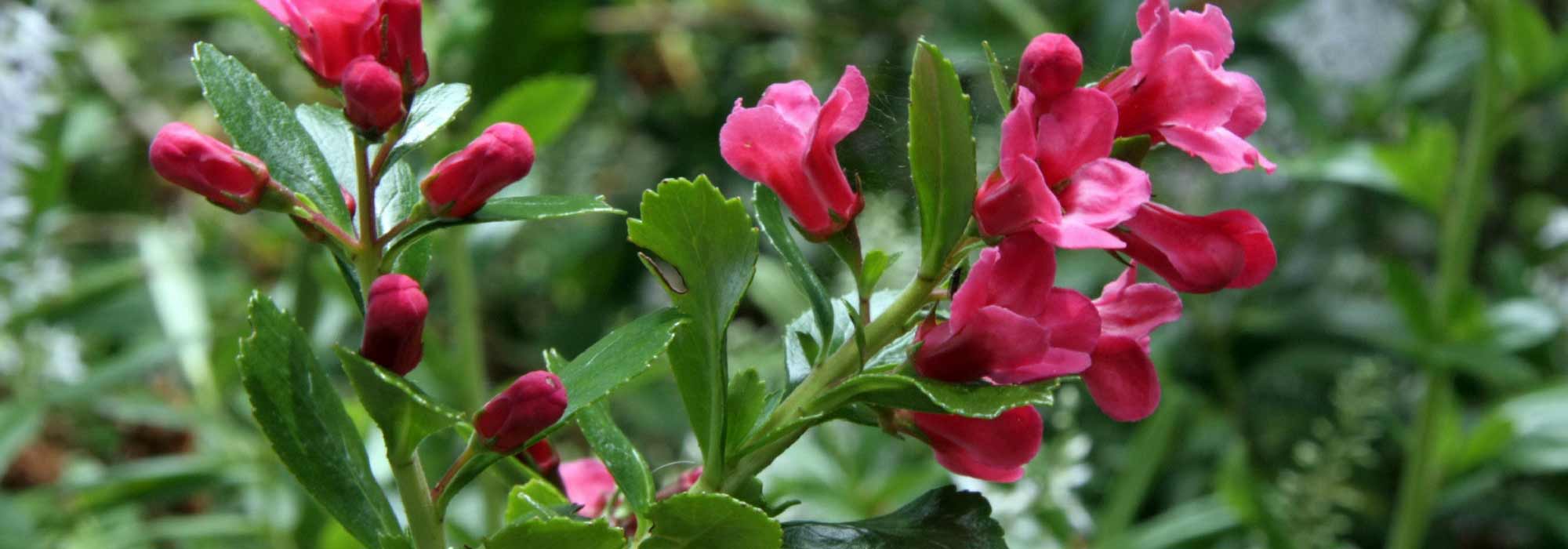
Escallonia: planting, pruning and care
Contents
Escallonia in a nutshell
- Escallonia is an essential bush in gardens of mild and coastal climate
- Its abundant and long-lasting pink or white flowering enlivens the garden throughout summer
- With its beautiful glossy green evergreen foliage, it makes an excellent evergreen hedge, whether free or pruned
- It thrives in ordinary, well-drained soil in full sun and sheltered from draughts
- Fast-growing, it is highly resistant to diseases, easy to maintain and cultivate
A word from our expert
The escallonia, with its generous pink or white flowering that lasts all summer, rapid growth, and evergreen foliage, either bright green or yellow, is one of those rewarding bushes that are essential in your garden if your climate allows it.
Well known to gardeners in Brittany or England, Escallonia is ideal for forming hedges by the sea. It compensates for its limited hardiness (-10°C) with good resistance to sea spray, making it unmissable in coastal gardens.
From white escallonia (Escallonia Iveyi) to red escallonia (Escallonia rubra), including pink escallonia, this beautiful evergreen bush is truly low-maintenance.
Escallonia loves the sun, tolerates shade, sea spray, and even dry summers once established. It thrives in ordinary, well-drained soil that is well-sheltered from cold winds.
We offer you numerous varieties of evergreen escallonias to plant in flowering hedges or borders… Discover them!
Description and Botany
Botanical data
- Latin name Escallonia
- Family Escalloniaceae
- Common name Escallonia
- Flowering from June to September
- Height 0.80 to 3 m
- Exposure sun, partial shade
- Soil type all, well-drained
- Hardiness -10°C
The genus Escallonia comprises around sixty species of evergreen bushes or trees, mostly native to the wooded highlands of South America, particularly Chile, the Andes, and Argentina. In the wild, these shrubs from the Escalloniaceae family grow among the underbrush on slopes or along coastal areas exposed to sea spray.
Escallonia rubra, with its red flowers, and E. virgat, one of the few species with deciduous foliage, have given rise to most hybrids. Escallonia rubra var. Macrantha, with larger leaves than the others, is one of the many forms that Escallonia rubra takes in its natural habitat.
Vigorous and of medium to fast growth, it forms a dense, branched bush, rounded or upright, reaching 3 m in all directions at maturity. The habit and vigour vary among hybrids; some horticultural hybrids (‘Red Carpet’) are distinguished by a spreading habit, bushy and very compact.
Escallonia is characterised by its beautiful, fragrant, glossy, and leathery foliage that generally persists through winter and brightens the garden throughout the year. Its small, dentate leaves, measuring 1 to 8 cm long, are arranged very densely along almost the entire length of the branches. They sometimes have a succulent appearance. Oval in shape, they are dark green and shiny in most species. Escallonia laevis ‘Gold Ellen’ features sumptuous golden-yellow foliage speckled with green.
This foliage is slightly aromatic when crushed.
The flowering is abundant and lasts all summer. From June to September, more or less early depending on the climate, fleshy flowers with five petals in a cup or semi-open tubular shape, depending on the species, bloom on the lush foliage.
Gathered in panicles or small clusters of 3 to 30 cm at the end of each branch, they range from pure white to red, including all shades of pink, from deep pink to crimson. These small tubular bells evoke, by their colour, waxy texture, and delicacy, the flowers of apple trees.
Escallonia is an excellent garden plant in mild climates. With a moderate hardiness of around -10°C, this frost-sensitive shrub prefers to be planted in full sun and protected from draughts, in a slightly acidic or neutral, fertile, and well-drained soil.
This easy-to-cultivate shrub is widely used in coastal areas, as an evergreen hedge, in borders, or in pots on a terrace.

The flowers of Escallonia: Escallonia ‘Apple Blossom’ / Escallonia rubra ‘Crimson Spire’ / Escallonia rubra ‘Macrantha’ / Escallonia ‘Iveyi’.
Main species and varieties
Escallonia rubra has given rise to most hybrids that mainly differ in size, either vigorous or ground-covering, and in their flowerings from white, pale pink to crimson. Some cultivars like Escallonia ‘Donard Seedling’ are hardier (-15°C) than most Escallonias which offer mediocre hardiness, around -5 to -10°C. The larger specimens will be perfect for evergreen hedges, while more spreading varieties like ‘Red Carpet’ will be used as ground cover, in a small hedge, or in a container on a terrace well sheltered from prevailing winds.
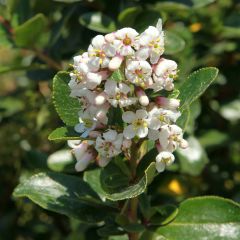
Escallonia Iveyi
- Flowering time July to October
- Height at maturity 2,50 m
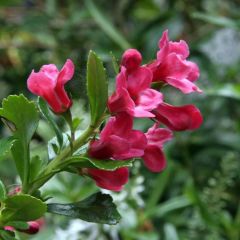
Escallonia virgata Pride of Donard
- Flowering time July to September
- Height at maturity 1,50 m

Escallonia virgata Apple Blossom
- Flowering time July to September
- Height at maturity 1,50 m
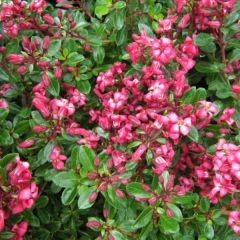
Escallonia Red Carpet
- Flowering time July to September
- Height at maturity 80 cm
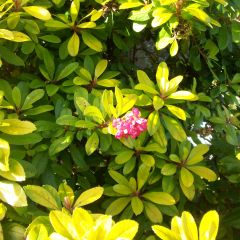
Escallonia laevis Gold Ellen
- Flowering time August, September
- Height at maturity 2,50 m
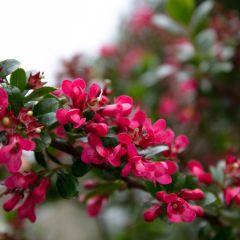
Escallonia Darts Rosy Red
- Flowering time August, September
- Height at maturity 2,50 m
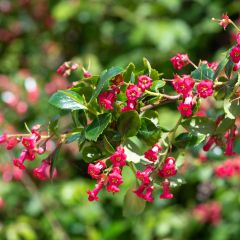
Escallonia rubra Crimson Spire
- Flowering time July to October
- Height at maturity 1,50 m
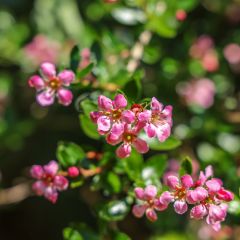
Escallonia Donard Seedling
- Flowering time July to September
- Height at maturity 2 m
Discover other Escallonias
View all →Available in 0 sizes
Available in 1 sizes
Available in 2 sizes
Available in 1 sizes
Available in 2 sizes
Available in 1 sizes
Available in 3 sizes
Available in 1 sizes
Available in 1 sizes
Available in 1 sizes
Planting
Where to plant the escallonia?
From its South American origins, the escallonia has retained a rather tender nature and a love for warmth. It fears only excessively calcareous soils or overly heavy ones, icy winds, and cold winters. It will still withstand light frosts of short duration down to about -10°C, once well established, and it will never do better than when sheltered from the wind!
It is an excellent subject for a free hedge or a border in a mild climate. Its thick, evergreen foliage tolerates marine spray well, making it a must-have in coastal gardens in Brittany, Ireland, or England. It also thrives in a Mediterranean climate, where it can withstand occasionally dry soil with good mulching and watering.
Elsewhere, its hardiness is often put to the test, although it is likely to regrow from the base in spring. It will only withstand negative temperatures in a well-sheltered situation.
Give it a warm, very sunny, and well-sheltered spot from draughts, facing south against a wall or west at the back of a border or in a hedge, especially in colder regions: it does not tolerate cold winter winds.
It loves the sun where it flowers more abundantly but tolerates partial shade well in a warm climate and even summer drought once well established. Not demanding regarding soil, it fears excessive limestone and appreciates well-drained, cool soil, preferably slightly acidic or neutral. It dislikes compact and waterlogged soils in winter; therefore, avoid flooded areas.
The largest specimens can reach 3 metres in height with an equal spread; they will look wonderful planted in evergreen, free, screening or trimmed hedges in temperate regions.
With its long, generous flowering, its always green foliage, and its robustness, the escallonia will advantageously replace conifers or Weigelas in mild climates, by the sea, as well as in dry or unwatered gardens.
More compact varieties like ‘Red Dream’ or ‘Red Carpet’, which do not exceed 80 cm in height, will be superb used as a large ground cover, in a small hedge or in a pot on a well-sheltered terrace.
When to plant an escallonia
The Escallonia is preferably planted in spring, from March to June, in the coldest regions, or in autumn in very mild climates, when all risk of frost has passed.
How to plant an escallonia?
In the ground
For hedge planting, space the Escallonia 60 to 80 cm apart.
- Soak the root ball in a bucket of water overnight before planting
- Loosen the soil well
- Dig a hole at least three times wider than the volume of the root ball and 50 cm deep
- Backfill with the extracted soil mixed with two buckets of compost and a little potting soil while keeping the bush upright
- Lightly compact the soil
- Spread an organic mulch of pine bark 10 cm thick, especially in warm regions
- Water generously at planting and then regularly during the growing season, especially for the first three summers following planting
In pot
- Ensure a fresh, well-draining mix based on potting soil for shrubs mixed with one or two shovelfuls of well-decomposed compost
- Choose a large container of at least 30 litres (30 to 40 cm in diameter) and create a bed of gravel or clay balls at the bottom
- Mulch the base
- Water well during the growing season and whenever the soil is dry
To learn more: Growing an Escallonia in pot
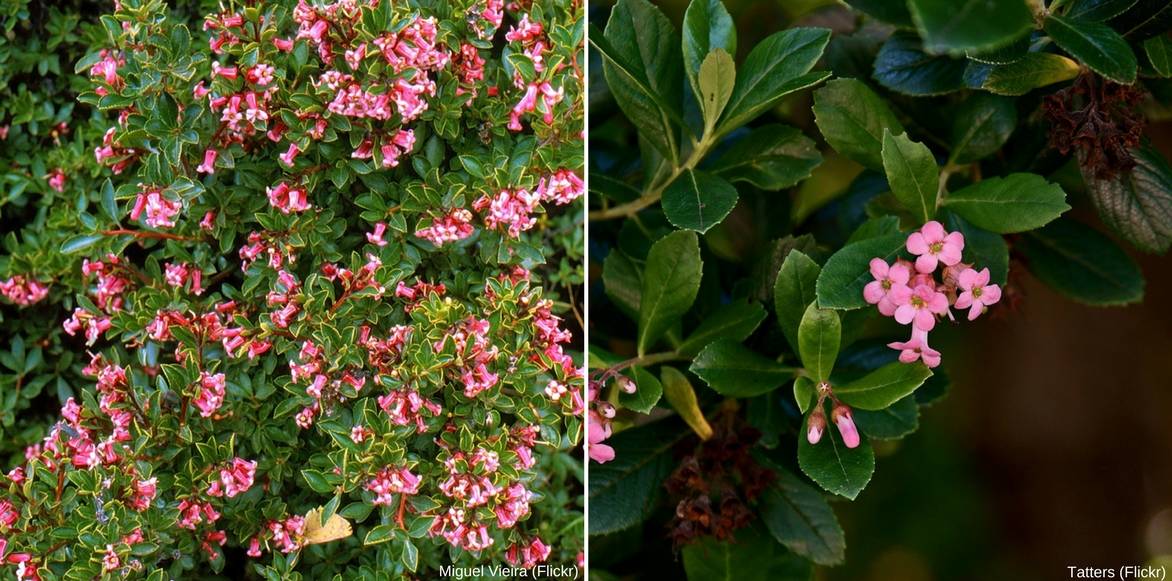
The abundant flowering of Escallonia rubra.
Read also
Be attentive to evergreen bushesCare
Escallonia is a truly low-maintenance bush that requires little care. In poor soil, consider adding an organic fertiliser in spring to stimulate its growth and flowering.
Spread a good layer of organic mulch (bark or pine needles, leaf litter), renewed each year, to keep its roots cool during summer heat and warm during winter.
Ensure it never lacks water in summer during the first few years: water regularly for the first three summers to help it establish well. Water potted escallonia more frequently as the soil dries out more quickly.
When and how to prune an Escallonia?
Escallonia grows quickly and often deserves a refresh 1 to 2 times a year if you want to maintain a balanced silhouette or to give it a lovely bushy shape. In the first few years, to help the bush develop a dense and compact habit, prune to one third of its height.
Prune each year at the end of winter, in February-March, when frosts are no longer a concern, to rebalance and refresh the branches, and at the end of summer, in September, after flowering.
- For isolated specimens, a spring refresh pruning is sufficient to rebalance or reduce the branches: with shears, remove dead or thin wood that disrupts the habit.
- Pruning escallonia is especially recommended for specimens used in hedges: with a hedge trimmer or lopper, slightly cut back the stems compromising symmetry and remove faded flowers. It can even be cut back more severely if you wish to reduce its spreading or reshape a specimen that is too sparse.
Escallonia can even be shaped into a ball.
Diseases and potential pests
Escallonia has no enemies and is particularly resistant to diseases and pests. It fears only one thing: waterlogged soils, especially in winter, and excess lime. If the soil is too limey, it can suffer from chlorosis, which manifests as a gradual yellowing of the leaves and ultimately leads to the decline of the bush.
Well-drained soil, regularly amended with compost or turf, will help prevent the disease.
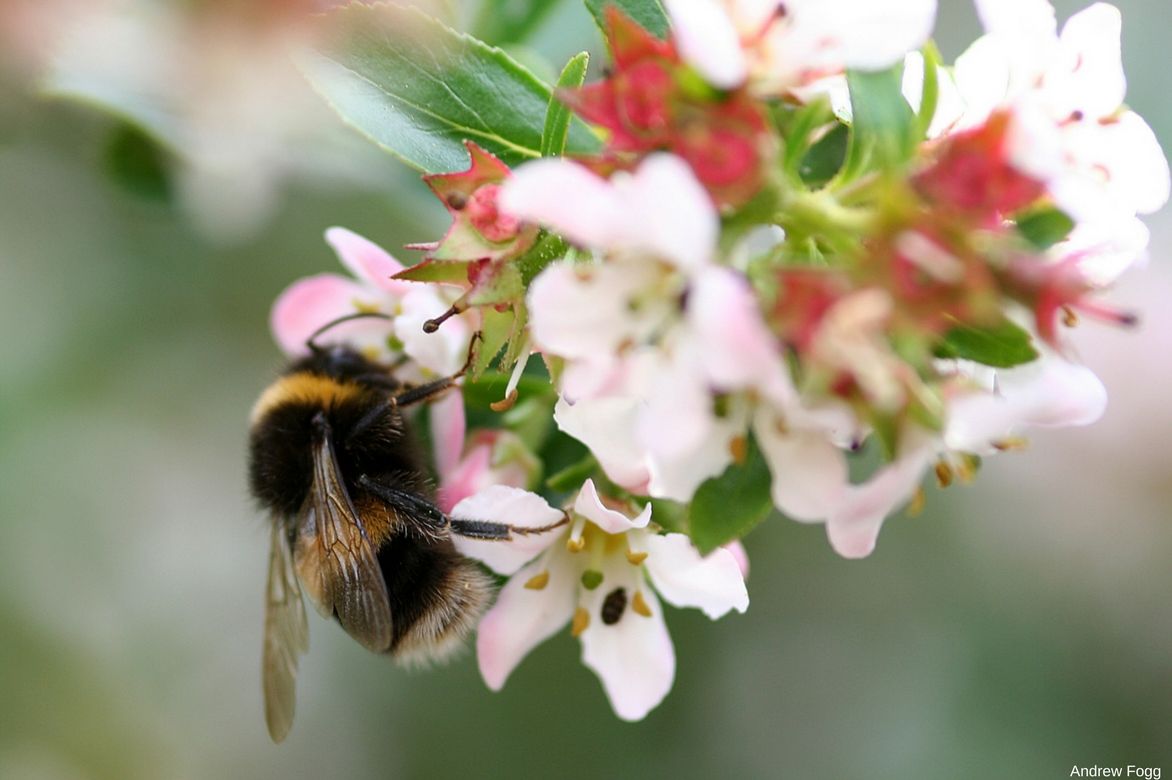
The flowers of Escallonia are melliferous.
Multiplication: propagating the escallonia
Escallonia is easily propagated by cuttings.
By herbaceous cuttings
- In June, cut a stem 10-15 cm below a leaf or an eye without buds or flowers
- Remove the leaves from the base, keeping those at the tips
- Plant in pots or trays in a light mix of turf and river sand
- Regularly moisten the cuttings and keep them sheltered and warm until rooting
- Transplant them in March-April into individual pots filled with potting soil and sand
- Plant out in the ground in autumn, when the root system is sufficiently developed
By semi-ripe cuttings
Proceed similarly in September with semi-woody stems (which transition from softwood to hardwood).
→ Learn more with our tutorial How to propagate Escallonia?
Associating
Escallonia is the must-have bush for our mild climate gardens, brightening them throughout the year with its lovely glossy evergreen leaves and abundant summer flowering that lasts until the first frosts.
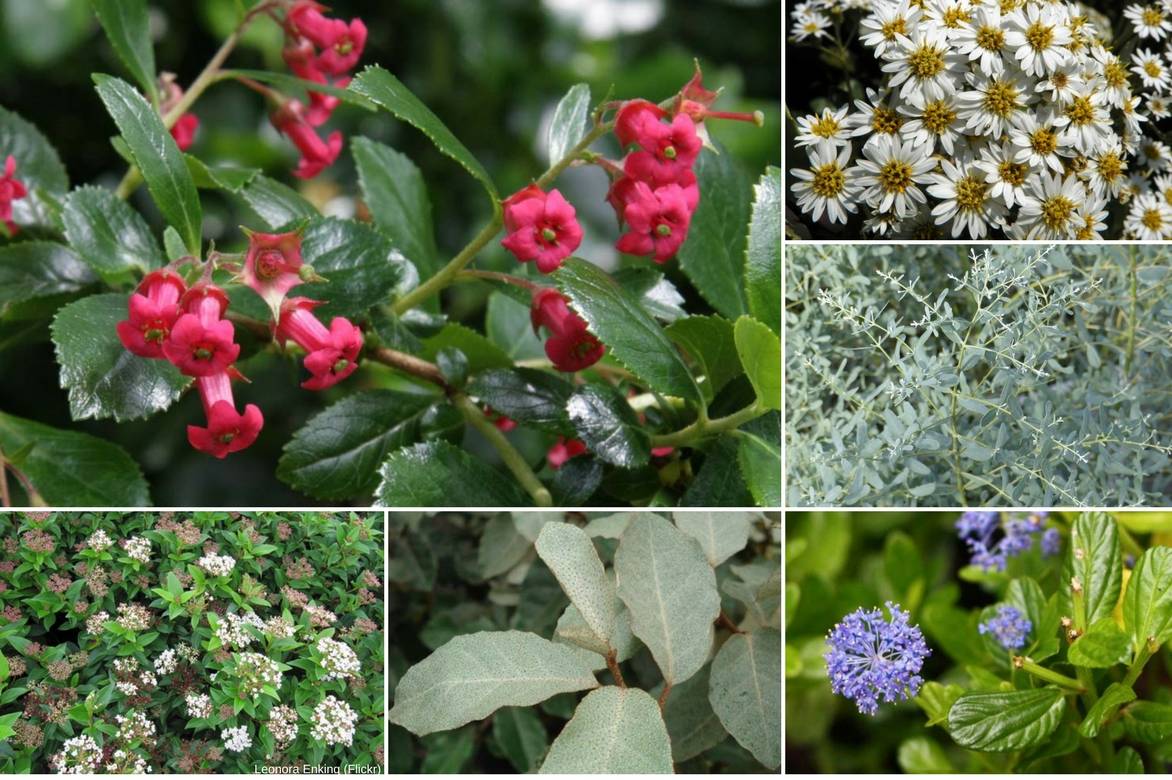
An example of pairing for an evergreen hedge in a mild climate: Escallonia rubra ‘Crimson Spire’, Olearia macrodonta ‘Major’, Eucalyptus gunnii ‘France Bleu Rengun’, Ceanothus impressus ‘Victoria’, Eleagnus ebbingei, Viburnum tinus ‘Eve Price’.
Centrepiece of hedges, it is essential in coastal and temperate gardens where it is often used in free hedges, borders, or in pots on a terrace.
In a flowering hedge, it will accompanydeutzias, a pink Japanese Dogwood, Hebe or shrubby veronicas, Oleander, and will brighten the grey foliage of the Chalefs.
In a large border, it will look wonderful alongside beautiful perennials such as Gaura, lavenders, hardy geraniums, Phlox, white or pink roses, or even summer or spring flowering bushes like Kolkwitzia amabilis, Broom (Cytisus ‘Zeelandia’), Cistus, buddleias, or ceanothus, for beautiful flowering scenes with little maintenance.
→ Discover 7 more great ideas for pairing Escallonia in our advice sheet!
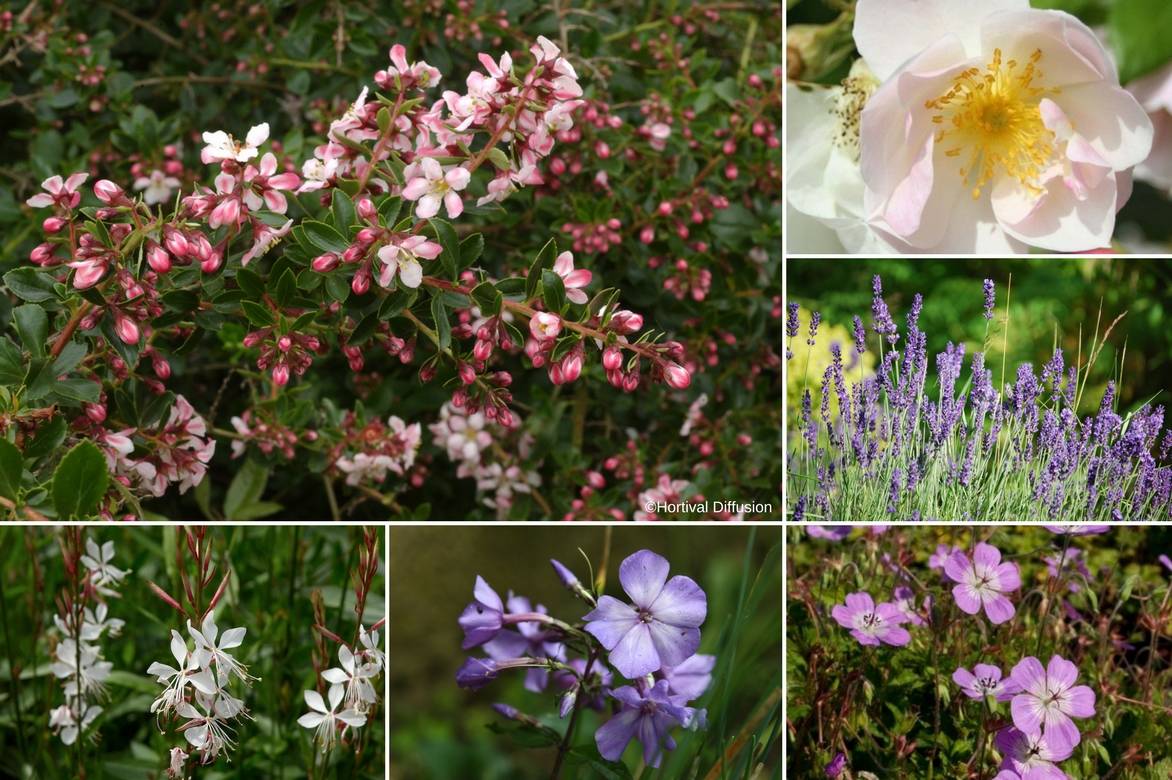
An idea for pairing in a border: Escallonia ‘Apple Blossom’, Rose ‘Nevada’, Lavandula officinalis, Geranium ‘Sylvia’s Surprise’, Phlox paniculata ‘Blue Paradise’, Gaura lindheimeri ‘Alba’.
Useful resources
- Discover the most beautiful escallonias to use in hedges or to grow in pots
- Find our tips in our guides: How to prune an Escallonia? and How to choose an Escallonia for your garden?
- Subscribe!
- Contents
































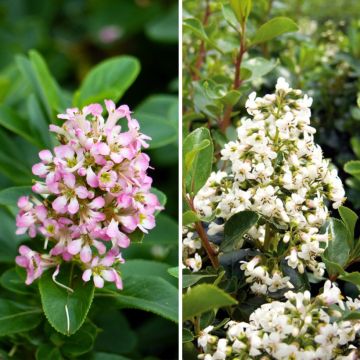


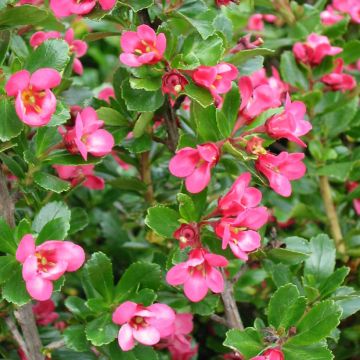
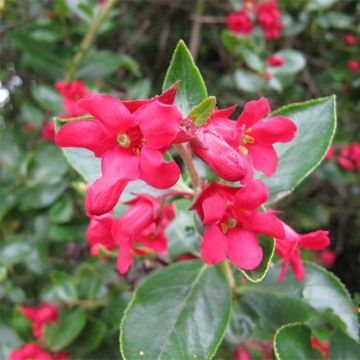
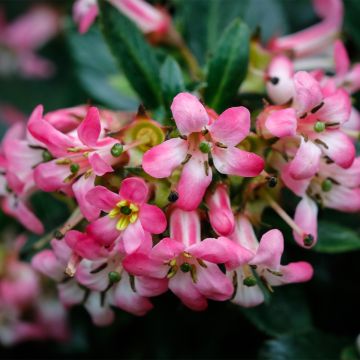

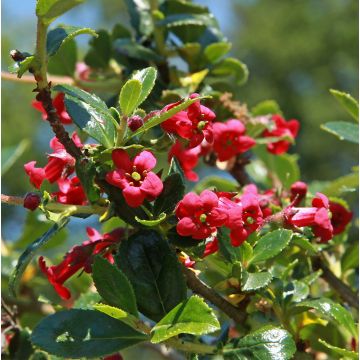
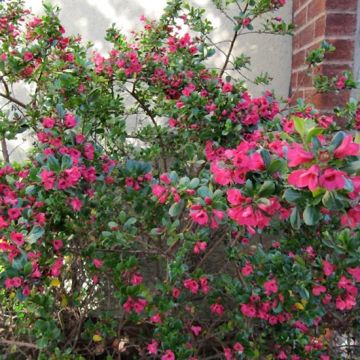
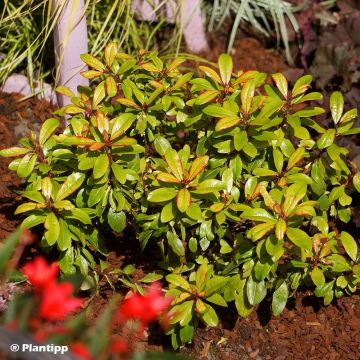
Comments